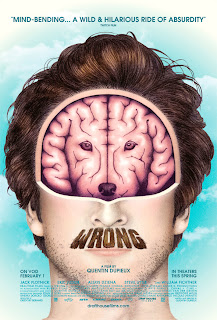If, by chance, any of you fine
folks out there, saw, and liked, Parisian-born, electronic musician
turned filmmaker Quentin Dupieux's last film, titled Rubber, a film
ostensibly centered around an abandoned car tire that somehow attains
sentience, and goes on a killing spree in the deserts of the southwest, murdering people with, what
seems to be telekinesis, then it is a pretty good bet that you might
just like the director's new film as well. But, if you are one of those
who thought Rubber was a, let's say, steaming pile of dog shit - and there are probably more of the latter than the former - then it
is an equally good bet that you should probably avoid this new film
like one would avoid the veritable plague. Lucky for me, I am in the former group, so Dupieux's simply titled, Wrong, though not as flat-out enjoyable as Rubber
(less frantic but more cerebral indeed), is just my so-called cup of
tea. Granted, this tea may very well have been laced with something
(think David Lynch meets Charlie Kaufman), but it still tastes pretty
darn good to me.
Now,
to set up the plot of this film for the non-initiated, may be a little
difficult. Sure, I can tell you that the film is about a man named
Dolph, who loses his dog, Paul. I can let you know that in actuality,
Paul has been kidnapped by a a mysterious self help guru who goes by the
name of Mr. Chang. I could also mention that there may be man/dog
telepathy involved, as well as mind control, matter-of-fact returns from
the dead, odd occurrences, such as a palm tree suddenly becoming a pine
tree, or a torrential downpour inside an office building, that is never
even questioned (much like the ever-burning house in Charlie Kaufman's Synecdoche, New York),
and to top it all off, time itself may have no meaning whatsoever. Oh
yeah, and we get to see the inner thoughts of a dog turd as well. And,
these things are merely the tip of the batshitcrazy iceberg that is
Quentin Dupieux's aptly titled, Wrong. Trust me, once you
experience the film's opening shot, you will know whether you are in the
rightest of places or in the the wrongest - all depending on which side
of the fence you were on with Rubber.
Overall, the film is not as purely enjoyable as Rubber, a film that abandoned all rights of narrative and acted as pure, unadulterated pulp kitsch, but it is still a decidedly fun film to watch. I mentioned David Lynch earlier, and any Lynchian worth their salt can see how influenced by the Maestro of Missoula, M. Dupieux obviously is. For those who would rather eat a sentient sociopathic rubber tire, than sit through anything even remotely similar to Rubber (though Wrong is quite different), all this ranting and raving and general hoopla over the director's new film, is probably all for naught, but what the hell. Really though, rant and rave is really all I can do, for fear of giving some plot twist away. Hell, even the twists that are seen coming, are better left to be seen than read. Outside of generalizations and hints at what is going down (did I mention the dog turd thing?) this is a film that you must see to believe. Being rather an odd duck myself (I did not think Rubber was really all that out there, nor did I find the aforementioned David Lynch or Charlie Kaufman to be all that out there either), Wrong does not come off all that...er, um...wrong, but I am sure there are those out there - those damn Rubber haters - that would think the whole shebang just downright wrong. Oh well, their loss.
Overall, the film is not as purely enjoyable as Rubber, a film that abandoned all rights of narrative and acted as pure, unadulterated pulp kitsch, but it is still a decidedly fun film to watch. I mentioned David Lynch earlier, and any Lynchian worth their salt can see how influenced by the Maestro of Missoula, M. Dupieux obviously is. For those who would rather eat a sentient sociopathic rubber tire, than sit through anything even remotely similar to Rubber (though Wrong is quite different), all this ranting and raving and general hoopla over the director's new film, is probably all for naught, but what the hell. Really though, rant and rave is really all I can do, for fear of giving some plot twist away. Hell, even the twists that are seen coming, are better left to be seen than read. Outside of generalizations and hints at what is going down (did I mention the dog turd thing?) this is a film that you must see to believe. Being rather an odd duck myself (I did not think Rubber was really all that out there, nor did I find the aforementioned David Lynch or Charlie Kaufman to be all that out there either), Wrong does not come off all that...er, um...wrong, but I am sure there are those out there - those damn Rubber haters - that would think the whole shebang just downright wrong. Oh well, their loss.




































